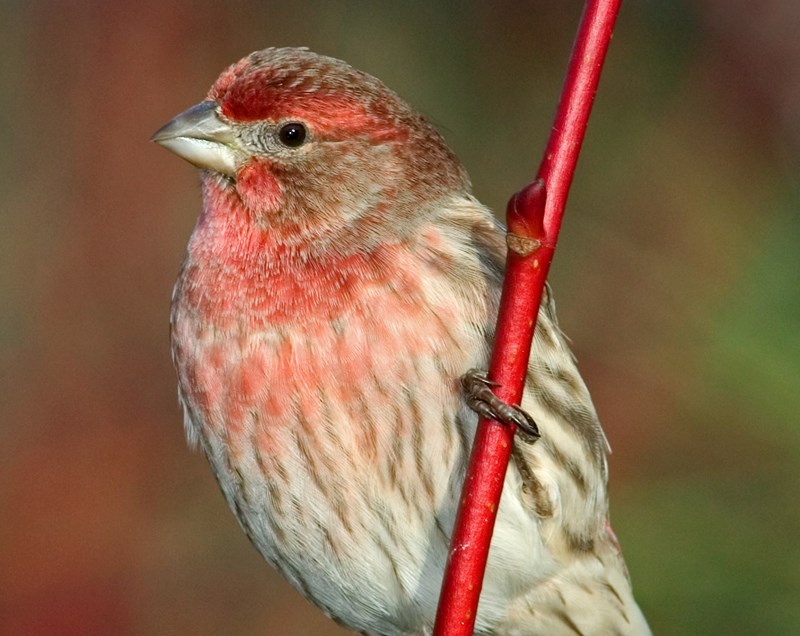One of the most enjoyable aspects of winter birding on the North Shore is our lovely variety of finches. They are colourful, lead fascinating lives, and are simply a joy to discover.
The question often comes up: What are finches and how do they differ from other birds?
Birds of North America sums it up nicely: “The most unifying characteristic among these groups (cardinals, sparrows, and finches) is the conical beak used for cracking hard seeds.” Some finches can even crack open cherry pits!
Incidentally, learning to recognize bill types can be very helpful, especially when spotting an unknown species. A bird’s beak is a tool for doing many kinds of tasks, such as feeding, nest building, and preening, or grooming.
Perhaps the most commonly seen finch on the North Shore is the house finch. Males are often red or orange, but they can also be yellow, so it pays to look carefully. The female has nice, brown-striped plumage. The house finch is frequently seen at bird feeders, where it enjoys seeds like premium oil sunflower or nyjer (thistle).
The house finch is sometimes confused with its cousin, the purple finch. Look for a white band behind the purple’s eye, which is not present in the house finch. Also, the male purple is a much richer colour than the house.
Note that if you travel to the interior of the province, such as the Okanagan, you will encounter the related Cassin’s finch. We do have a few records of them locally.
The American goldfinch is another North Shore finch seen at bird feeders or feeding on alder or birch seeds. In winter, the male loses his bright yellow plumage and looks more like the female. It also enjoys oil sunflower and nyjer. In all plumages, it is a truly lovely bird.
The pine siskin is kin of the goldfinch. Look for yellow wing bands – sometimes they are quite bright. Watch for them at feeders or foraging on alder seeds. This species has a distinctive “zeep” call that – as nature recordist John Neville describes on his excellent birding CD – is like someone drawing their thumb across a plastic comb.
With siskins, or by themselves, in birch trees, you might be lucky enough to spot some brown-striped birds with pinkish crowns – you’ve discovered redpolls. The redpoll species we see on the North Shore is the common redpoll. Numbers vary widely from year to year, but there are always a few waiting to be discovered.
A large and spectacular finch that used to be seen more often in winter is the evening grosbeak. As its name suggests, it has a huge beak. The male is bright yellow with a white forehead; the female a gentler yellow. Its loud “chirp, chirp” is very distinctive.
We don’t think of finches as fruit eaters, but they are. The purple finch can often be found in Pacific crabapple trees – a good place to look for all kinds of birds in winter.
The pine grosbeak male is a lovely pinkish colour, while the female is a soft grayish. Hawthorn fruits are a winter favourite, but seeds are also enjoyed. Cross-country skiers and snowshoers should watch for pine grosbeaks along winter trails.
“Kip, kip, kip,” is the distinctive flight call of the red crossbill and, yes, it does have a crossed bill – some to the right, some to the left! The crossed bill is an adaptation for extracting seeds from conifer cones. Interestingly, at the Conservation Area at Maplewood Flats, crossbills are sometimes seen on the seashore (maybe getting salt) or feeding on tree buds. The white-winged crossbill is a rarer species to be watched for along mountain trails on the North Shore.
Speaking of the North Shore mountains in winter, there is a very lovely species called the gray-crowned rosy finch. Seeing it is always such a thrill. It is sometimes seen pecking along the sides of roads and trails.
A good place to observe finches up close is the feeding station at Maplewood Flats. Feeders and seeds supplied by Wild Birds Unlimited attract many wonderful species of birds.
Enjoys your birds. Keep safe.
Al Grass is a naturalist with Wild Bird Trust of British Columbia, which offers free walks at The Conservation Area at Maplewood Flats on the second Saturday of every month. The next walk will be Saturday, Jan. 14. Meet at WBT’s site office, 2645 Dollarton Hwy., North Vancouver. Walks go rain or shine. wildbirdtrust.org



